Orangutans of Borneo
2Monday 26 October 2015
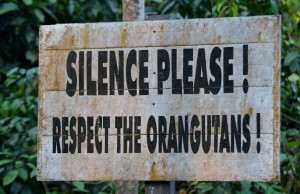 Borneo is well known for its jungles and wildlife and Susie and I were dead set on taking Adina to see the orangutans that can be found there.
Borneo is well known for its jungles and wildlife and Susie and I were dead set on taking Adina to see the orangutans that can be found there.
From Sulawesi it meant four days of sailing – we have been whipping up the miles over the last six weeks! Indonesia has some very shallow waters and for a few days we found ourselves sailing in depths ranging between fifteen and twenty-five metres. When on passage in Vanuatu, the Solomon Islands or Papua New Guinea you could easily take a little cat nap on a night watch as you’d never see a thing. Not so in Indonesian waters, you need to be positively alert. Big international cargo boats or tankers have AIS (Automatic Identification System) which means we can see them on our navigation system and more importantly they can see little us; we each know what the other is doing and can clearly see if we are on a collision course. Not so the Indonesians boats. Quite often you see big groups of fishing boats with bright spotlights fishing for squid or even worse smaller fishing boats with little more than flashing LED lights that look like disco lights. Then there are the tug boats which fortunately can be seen with their bright ‘restricted in ability to manoeuvre’ lights but not so the usually large item they are towing on which, at best, they simply put a tiny LED light. And in these shallow waters some boats will even anchor. It keeps you on your toes working out who’s doing what.
We arrived at the Kumai river entrance at the break of dawn to be greeted by forest fire smoke which has been plaguing Indonesia since September. These fires are caused by the burning of palm oil plantations and the simple ‘slash and burn’ that happens here at this time of year. The forest fires have caused problems as far as Malaysia and Singapore and schools in Singapore had to be closed as pollution reached dangerous levels. It certainly produced the odd cough on board Adina as our lungs adjusted to their new environment.We motored eighteen miles up the muddy river which is shallow in spots but we had plenty of safe waypoints to navigate our way. The tide was against us – you can’t win them all. Anchored off the town of Kumai were Neville and Glenys on their boat Alba who we had first met in the Tuamotos last year. We’d been in email contact and arriving first they had kindly booked a three day, two night cruise for the four of us to see the orangutans.
The next day we left Adina behind with a local security guard and headed off. Funnily enough our biggest concern leaving Adina was whether the freezer would last three days in these warm equatorial waters. Inside the freezer were our last treasured Vanuatu steaks and around twenty lobster tails from Papua New Guinea!
The boat for our chosen cruise was positively lovely. A double-decker, we spent our time upstairs where there was a table and chairs for eating and four comfortable chairs out front on an open deck from which to watch the jungle and river glide by.The Tanjung Puting National Park has three orangutan feeding stations providing food for orangutans that have been rehabilitated into the wild. Luckily for us tourists we are allowed to visit them! In addition to these stations the jungle abounds with proboscis and macau monkeys and the odd gibbon can be seen too. Birds are plentiful and in between demolishing big meals we enjoyed some wildlife spotting. We were certainly well fed, Susie and I relishing the Indonesian food after months of eating assorted sweet potatoes, fish and coconuts.
The feeding stations consist of large wooden platforms on stilts located in small openings in the forest. At a fixed time each day the park officials deposit a very large pile of bananas and bowls of milk with vitamins on the platform. They then wonder off into the bush and make various loud calls summoning the orangutans to their meal. We were to learn that orangutans are solitary creatures and a mother looks after a young one for eight years teaching it everything it needs to know, such as what to eat or not to eat. The reason behind the feeding is to ensure the rehabilitated orangutans don’t go hungry as they settle back in to life in the wild. In theory a day when no orangutans turn up is a good day as that means they are finding food for themselves. Not so good for our cameras. The platform is fenced off by a rope and we, their closest relatives, sit patiently on wooden benches hoping for an orangutan to arrive. It’s a little like being at the theatre – with a rustling of some tree leaves eventually one appears and comes on stage. The milk is clearly popular and our first orangutan had a super method of scooping it up in his one hand, lifting it high and then, sticking his lips far out, poured it in to his mouth. Rather like lifting a pot of tea up high and pouring it into a small cup. Quite some party trick. He’d stop, look at us, then have another scoop. And then on to the bananas which are peeled with ease and quickly consumed. And orangutans make up their own recipes. A popular option was to stuff three bananas in your mouth, make them into a ball, take the ball out, dip it in the milk and then eat. Borneo banana balls served with milk and vitamins. A typical visit lasts about ten minutes in which an orangutan takes its fill and then, stuffing as many unpeeled bananas as possible into its mouth and carrying a few more in one hand, saunters off into the jungle, climbing high up into the trees.You sit and wait for the next visitor. The first sign of an approaching orangutan is the sight of moving leaves high up in the trees. The way they move between trees had us riveted. They will often climb high up a tree and rock it until it starts to swing. Once it gets swinging they continue until they can grab the next tree and gracefully move into that. And so they move from tree to tree before descending down to earth and onto the platform to feed.
The mothers with their babies were always fascinating to watch. Being solitary the mother keeps a look out while eating. The baby always has one hand clinging on to the mother and like in any good theatre the crowds gasp and ‘ooh and ahh’ as the baby moves to dip its tiny little head into the bowl of milk.A gibbon monkey called ‘Boy’ has locked into the Camp Leake feeding station and turns up every day to enjoy the bananas although he showed no interest in the milk. With long arms he’d sweep from tree to tree and then grab a few bananas before climbing into a tree next to the platform and sit rather nonchalantly eating his fruit before descending for a few more.
And so we spent our three days leisurely moving between feeding stations, doing a few walks, eating, catching up with Neville and Glenys and generally being content with life. On our last day we were walking up a wooden boardwalk when we spotted a young male called ‘Atlas’. It’s quite something to get close up to these orangutans and he seemed unfazed by his cousins, the humans. Sitting in the tree, Atlas decided he would pass over the top of us in the trees over our heads. Neville and Tom quickly got the cameras out as he posed. Susie and Glenys were in the background and decided to do an impromptu pose for a picture with an orangutan overhead. At this moment Atlas fell out of the tree – nearly on top of Susie and Glenys! Looking not too pleased, he gave them a disgruntled look and walked off. Sadly this blog isn’t big enough but if you head over to Facebook you can see the very funny sequence of photos on Tom’s page.
One last treat at our final visit to a feeding station was the visit of a mature male. The males are said to be eight times stronger than a human male. Large and with very impressive big cheek pads, he was quite a sight. On this visit we had orangutans appearing left, right and centre and it was hard to keep up. Our guide told us the bananas make the mature males amorous. Alpha males will also chase off any younger males. The male was sitting in the tree when he started making loud noises and suddenly went crashing through the trees. We weren’t sure if it was to scare off another male or trying to impress the ladies but you certainly wouldn’t want to mess with him.The three days of living the easy life were up all too quickly and we returned to our boats, Adina and Alba. The battery gods had been kind and our steak and lobsters were still nicely frozen, averting the need for an impromptu feast.
While the forest fire smoke had been bad at dawn and dusk each day, during the daytime it had largely cleared up so hadn’t presented any real problem. The day we left it suddenly became thicker and we motored down the river wearing masks, our next destination the island of Belitung, a two day, two night passage away.
Seeing the orangutans proved to be the highlight we had hoped it would be. They enchanted us with their behaviour and expressive faces, delighted us with their play and grabbed our attention as they swung effortlessly between the trees. We were glad we had taken the chance, despite the forest fire smoke. Might even try some banana balls dipped in milk and vitamins one day.
More pictures – click here

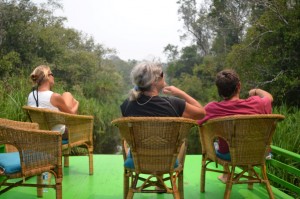
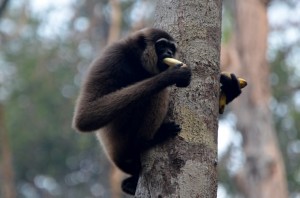
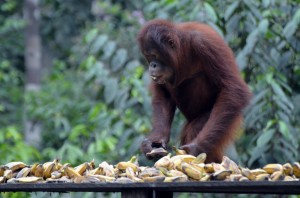
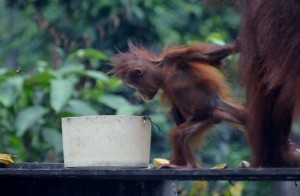
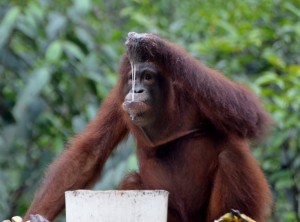
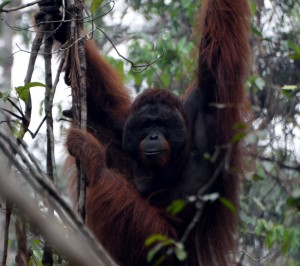
Hi lads,loved the photos,sorry we missed ye backalong.we now in port dickson after direct sail from Ketawai.Indonesian navy are patrolling Selat Durno after some boardings last week.
🙂 Many thanks for sharing this. You did really well seeing these big apes in their own habitat. You probably know ‘orang utan translates as ‘man of the wild/forest’ from Malay Any hornbills?.Happy travels.